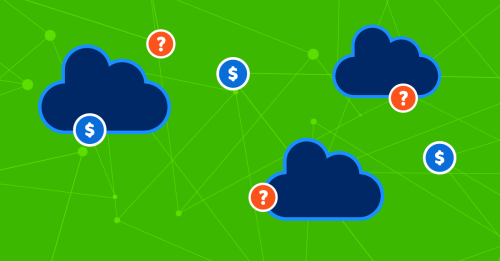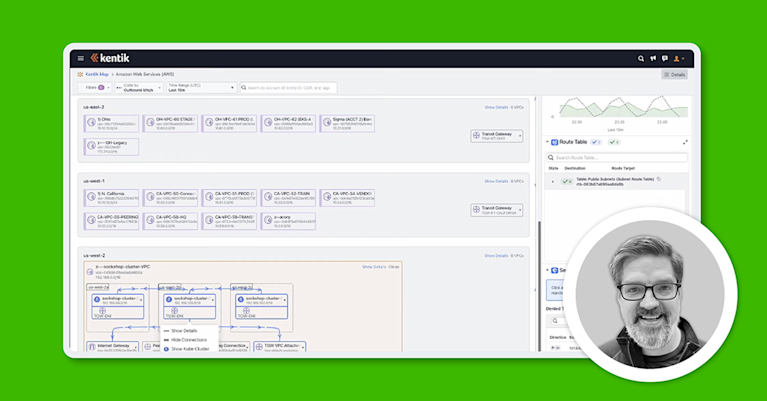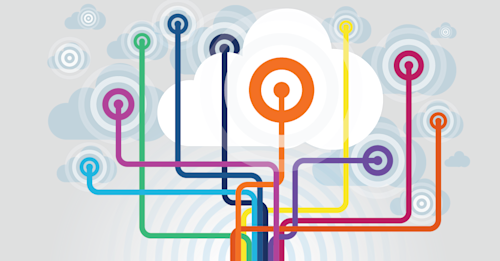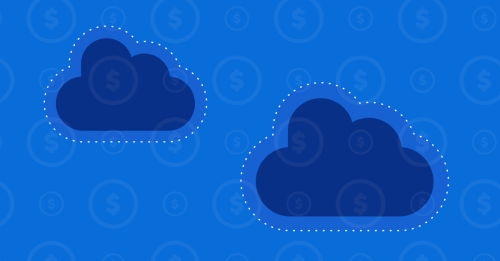Implementing a Cost-aware Cloud Networking Infrastructure

Summary
Cloud networks introduce a multitude of costs that can become challenging to predict. Learn how to implement a cost-aware infrastructure through maximum visibility in cloud networking.
What is cloud networking?
Cloud networking is the IT infrastructure necessary to host or interact with applications and services in public or private clouds, typically via the internet. It’s an umbrella term for the devices and strategies that connect all variations of on-premise, edge, and cloud-based services.
Why is cloud networking important?
Being able to leverage cloud services positions companies to scale in cost and time-prohibitive ways without the infrastructure, distribution, and services of cloud providers. Gaining access to these vast cloud resources allows enterprises to engage in high-velocity development practices, develop highly reliable networks, and perform big data operations like artificial intelligence, machine learning, and observability.
These distributed, data-intensive architectural components require layers of abstraction for deployment, orchestration, security, observability, and platform integrations, creating complex and dynamic networks. Cloud networking helps enterprises ensure these connections are cost-effective, secure, performant, and reliable.
Cloud networking vs. cloud computing
Cloud networking can be thought of as a subset of cloud computing. Cloud computing includes all the concepts, tools, and strategies for providing, managing, accessing, and utilizing cloud-based resources.
The different types of cloud networking
When you encounter the phrase “cloud networking,” it may refer to several specific subsets of cloud networking, including, but not limited to:
- Hybrid cloud networking
- Multi-cloud networking
- Cloud-based networking
Multi-cloud networking
Multi-cloud cloud networking refers to networks that use multiple cloud providers. For example, a particular microservice might be hosted on AWS for better serverless performance but sends sampled data to a larger Azure data lake. The resulting network can be considered multi-cloud.
Hybrid cloud networking
Hybrid cloud networking refers specifically to the connectivity between two different types of cloud environments. A hybrid cloud network could involve connections between on-premise private, hosted private, and public clouds.
Cloud-based networking
Slightly different is cloud-based networking, which refers specifically to networking solutions that offer a control plane hosted and delivered via public cloud. This might include caches, load balancers, service meshes, SD-WANs, or any other cloud networking component.
Designing a cloud networking environment with cost in mind
With their planet-wide data centers, a full suite of features, and resources for developers, cloud providers offer unparalleled capabilities in scaling and distributing applications across multiple availability zones (AZ), all while minimizing expenses like overhead for data centers and managers.
However, cloud networking presents some unique challenges for network operators and engineers accustomed to managing on-prem networks. Many of these resources and services have highly complex pricing structures, involve significant transit fees at scale, and their distributed nature can expose organizations to unexpected network scenarios that, ultimately, result in unforeseen costs.
Here are some common features and scenarios that cloud network operators should consider.
Instance types
Cloud resources are made available to customers in various instance types, each with special hardware or software configurations optimized for a given resource or use case. Some common instance types include:
- General purpose
- Memory optimized
- Compute optimized
- Storage optimized
- Accelerated computing
With accessible interfaces, making configuration decisions on cloud platforms is easier than ever. This is a double-edged sword, as selecting the wrong instance type for intensive applications or workloads can lead to significant cost inefficiencies.
On-demand vs. Reserved vs. Spot
One of the ways cloud providers guarantee availability is by entering into contracts with customers. These contracts can broadly be grouped into three types, each with their corresponding degree of expectations around resource availability (cloud provider) and commitment (customer):
-
On-demand. With on-demand pricing, the customer provides zero commitment to the cloud provider. As such, on-demand pricing is elastic to supply and demand and is typically the most expensive option. Network operators should beware of using on-demand pricing for long-running or resource-intensive workloads, as this can expose the organization to dramatic costs in high-demand windows.
-
Reserved. Reserved instances allow customers more competitive rates at the cost of some time commitment to the provider. They are also complex, involving varying costs for different term limits, activation windows, AZs, regions, and instance types.
-
Spot. With spot instances, operators bid at competitive rates for instances. Spot instances are an attractive option for short-running workloads or uses that are not hindered by interruptions, as they imply no guarantee of availability from the provider.
With the potential for dramatic variability in pricing, it’s crucial for operators structuring their cloud networks to be mindful and intentional of the architectural effects of their pricing decisions. For example, spot instances will always be the most affordable, but they require more reliability engineering to keep services up. Spot instances also require dynamic responses to instance market adjustments, which can mean additional engineering or oversight.
Traffic costs
One of the key cost factors for cloud network operators to consider when designing an infrastructure is traffic. What data is moving, how much of it, via what methods, and between what points in the network are critical in determining traffic costs.
Much the way spot instances allow organizations to bid down, network operators responsible for large amounts of traffic can enter into peering relationships that help facilitate efficient use of network resources while maintaining a quality end user experience. Similarly, architects and operators must remember that data doesn’t have to be moved over the public internet, and private backbones can be established for more secure and affordable data transfer.
How Kentik supports cost-aware cloud networking
As the complexity of a cloud network grows, so do the opportunities for network costs to behave in unexpected ways. For such large systems, rapidly diagnosing issues, automating solutions, and predicting shifting sands that might spell trouble for the network (or your bottom line) is vital.
As a network observability platform, Kentik provides a single pane of glass for managing and making the most of your cloud networks. By combining traditional network monitoring data like SNMP and NetFlow with a global and real-time stream of device and security telemetry, Kentik gives network operators and engineers a look at network activity that is fine-grained, comprehensive, and rich with context.
Incident resolution
When something goes wrong in a cloud network, mitigating the ripple effects and finding the root cause can be an overwhelming and costly endeavor. Ephemeral connections, cascading failures, siloed engineering, and monitoring efforts all contribute to a maze of alerts and network data that is difficult to parse or synthesize.
Kentik offers operators a range of troubleshooting tools, including customizable and real-time queries, dynamic network maps, and a range of integrations to trigger responsive alerting and mitigation workflows.
Connectivity costs
As covered above, costs associated with moving traffic into, out of, and between your networks can be some of the most difficult to manage. Kentik Edge gives operators a look at their network’s boundaries. By compiling pricing and network data, Kentik helps organizations compare billing statements directly to usage, surface cost trends and predictions, guide capacity planning, and traffic engineering, and even dynamically negotiate and monitor peering relationships.
This level of visibility into and control over network traffic gives operators the upper hand in efficiently managing connectivity costs.
Security
Cloud networks offer an immense surface area for malicious actors. Many modern cyber threats are also cloud-based, and with access to cheap virtual machines, attacks have become more sophisticated and harder to identify in network activity until some sort of interruption or compromise has already occurred.
Kentik’s network security offering, Kentik Protect, unifies and compares network, device, and threat telemetry to surface anomalous traffic before the network is compromised. It enhances the ability to investigate and understand attacks with deep ad-hoc traffic analysis and powers automated mitigation solutions once a threat has been identified.
Optimization
Software versions, customer regions, and a range of other data points all provide critical context when searching for cost and performance efficiencies.
By providing deep, context-rich insights around resource utilization and traffic patterns, Kentik is excellent for establishing baselines around cost, performance, and reliability and systematically testing improvements to your network.
Conclusion
Cloud networks introduce a lot of opportunities for costs to become challenging to predict, but implementing a cost-aware infrastructure is possible:
- Be mindful to choose the correct instance types throughout your cloud network
- Understand the best-fit pricing plan for the use case
- Manage traffic and peering relationships efficiently
- Introduce a network observability solution to provide the visibility needed to make these decisions, keep the system humming against performance and security issues, and search for optimizations
To see how observability can make your cloud networks cost-aware, sign up for a demo.



